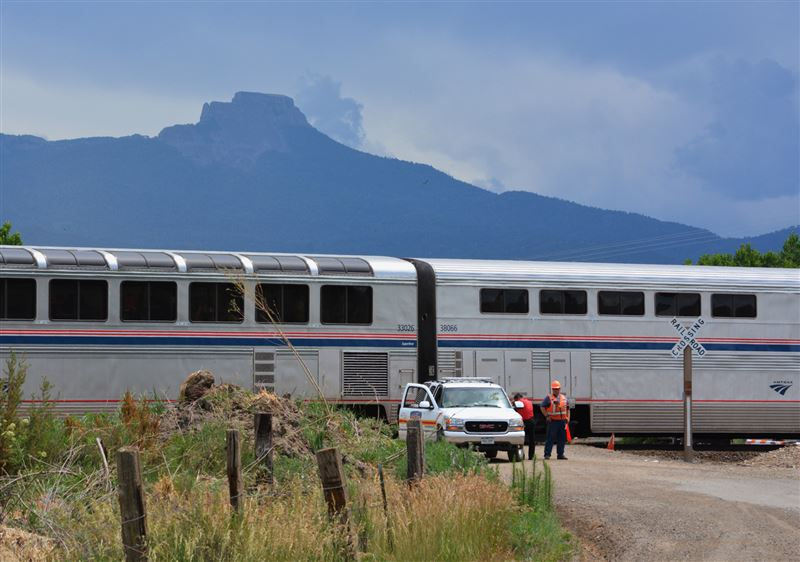Two for the sad books
- by Charles A. Turek
- Jul 6, 2016
- 3 min read
This week, I want to focus on two railroad accidents that resulted in unnecessary loss of life. The first was the unfortunate Sunday, June 26, 2016, grade crossing accident south of Trinidad, Colorado, involving the Southwest Chief. The second is the unusually fiery, June 28 head on collision of two BNSF Railway container trains in Panhandle, Texas.

So first to the grade crossing accident. Some people are still amazed that road-railroad grade crossings without flashing lights and gates still exist. What amazes me, however, is that anyone can think that it’s okay to drive a private passenger vehicle over one of these crossings without performing the old ritual, “Stop, look and listen!” Trains have been around since long before anyone living today. Operation Lifesaver (OL), the railroad sanctioned public safety campaign to prevent just such grade crossing accidents, has been around since 1972. That’s forty-four years! The OL offshoot known as See Tracks Think Train (seetracksthinktrain.org) has been out there trying to get to the text and selfie crowd for several years. And, for the life of me, I do not know why crossbucks, those familiar white Xs now just say, “Railroad Crossing,” and not, “Stop, Look, and Listen.”
I just want to make it clear—again—that Positive Train Control (PTC) as currently envisioned and configured by the railroads and Congress does not prevent grade crossing accidents per se. There are situations where, in full operation, it could be successful in stopping a train before a blocked crossing is reached. Those situations depend on a lot of factors, some of which are not automatic, and, just like a crossbuck and unprotected crossing hinge on the vigilance of people in close proximity. (Perhaps it should have been called APSTC—almost positive, sometimes.) The many too many grade crossing accidents we see at protected (lights, bells, gates) crossings each year also proves that automatic protection also does not prevent these things without some vigilance exercised by the public at large.
In any case, my heart goes out to that unfortunate family, five of six members of which were taken from us by the apparent decision of a driver to drive across active tracks. We may never know whether the ritual was performed, but I would guess it was not.
Then there was the head-on collision. It should not have happened, even without PTC.
All of the research available to me indicates that the BNSF is a two-main-track line through Panhandle. Eastbound trains are actually moving east-northeast, westbound moving west-southwest. The line appears to be signaled for both directions for both main tracks. Through Panhandle, there are a number of extra tracks for grain operations. All appear to be switched into the south main track at both ends. About one mile east of the last grain switch, there is a fully-signaled double crossover.
I have reviewed available video of the wreck, including a remarkable cellphone video presented on trains.com and showing the eastbound train passing a stopped eastbound, presumably on the south main track but possibly on the grain track, and burying itself into the westbound. I am fairly confident from this and other photography that the point of impact for this collision was west of the double crossover. Was the westbound supposed to wait while the eastbound cleared the stopped train and crossed over? If so, this would suggest a switch-signal interlock malfunction (unlikely) or somebody dropped the ball. Did the westbound blow a signal or did the eastbound fail to slow and derail into the stopped westbound. Eventually we will know.
What would PTC have done? PTC would have hit the brakes for a westbound red signal, not just upon blowing the signal but long before getting within proximity of even having the chance of moving through a crossover set against it. PTC would have slowed the eastbound if it were going too fast. Here’s an instance where PTC would have helped.
It will be interesting to see if, after the very hot diesel fires, there is enough left of the event recorders on both lead locomotives to determine what happened. Fortunately, one crewman survived and will probably state his version when healthy enough to do so.
Neither accident should have happened. The loss of eight lives on BNSF track within one week is a disaster that underscores the need for increased vigilance and continued safety education in the operation of all railroads and for the general public.
©2016 – C. A. Turek – mistertrains@gmail.com
(Charles A. Turek is a writer and novelist based in Albuquerque, NM. After four decades working in areas of the insurance industry related to transportation, he now writes on all aspects of American railroading. Charles is a political conservative but believes in public funding of passenger rail as a part of the federal government’s constitutionally conservative obligation to provide for defense and public infrastructure so that private enterprise may flourish.)

![maxresdefault[1].jpg](https://static.wixstatic.com/media/cef8ab_8d4e0ddce355463e8edabd7c8937b6f6~mv2_d_2500_1406_s_2.jpg/v1/fill/w_124,h_70,al_c,q_80,usm_0.66_1.00_0.01,enc_avif,quality_auto/maxresdefault%5B1%5D.jpg)



















Comments